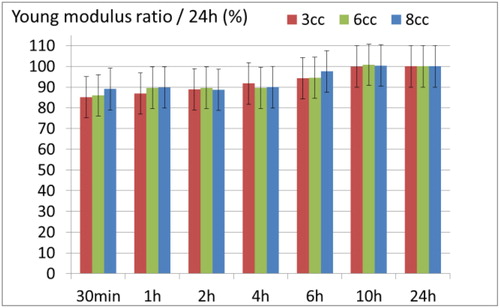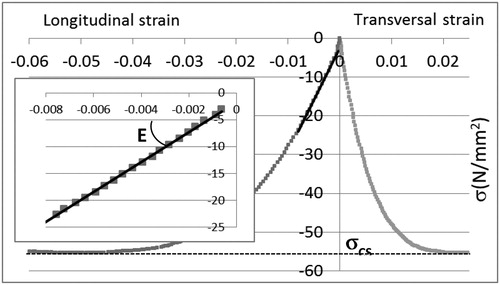1. Introduction
Polymethyl-methacrylate (PMMA) cement is now a common solution for the management of fractures: tibial plateau fracture depression (Vendeuvre et al. Citation2013), vertebral compression fracture (Garfin et al. Citation2006), calcaneus fracture,… In these cases, injection of cement plays a role of stabilization of the fracture after a reduction process performing with a balloon inflation. PMMA is a thermoplastic material obtained by polymerization of methyl methacrylate monomers following an exothermic reaction characterized by a thermal peak up to 75°. The storage environment, the ambient temperature, the preparation technique, the cement thickness are different elements that could modify PMMA performance.
Properties of PMMA for its use in surgical cases were widely studied by many authors. For example, Giddings et al (Giddings et al. Citation2001) showed the variation of the Young’s modulus and the tensile strength according to the temperature.
In the present work, the main objective was to determine mechanical behaviour of PMMA cement just after polymerization and the delay needed after the surgery for the patient to move safely without risks of damage due to mechanical properties.
2. Methods
2.1. Material and mechanical loading
The tests were performed on PMMA cement Xped from Medtronic Kyphon® company.
To study volume contribution, three injected quantities were considered: 3, 6 and 8 cm3 which represent the three volumes commonly used in surgery. We used specific moulds with a diameter of 16 mm and different deepness. We elaborated the specimens with similar conditions than the ones encountered in surgery: storing at 5 °C 24 h before using and mixture at ambient temperature (PMMA always at 5 °C). Moulds were preliminary placed in an oven at 37 °C before and after filling.
The specimens have been tested after different delays from the mixing step: 30 minutes; 1 h; 2 h; 4 h; 6 h; 10 h and 24 h. To measure the temperature of the specimen during polymerization, we used thermocouples have been placed in the inner face of the mould. Each specimen has been removed from the oven just before the mechanical tests and placed in a loading test machine with a temperature preserved at 37 °C using hot air flow. The specimens have been loaded in compression with a speed rate of 0.5 mm/min.
We also performed cyclic to analyse the contribution of repetitive loading and various loading speeds (0.125 mm/min and 2 mm/min) on the elastic properties.
2.2. Strain measurement
We have measured longitudinal and transversal strains during loading by using a mark tracking techniques. This technique consists in deposing four marks at the center of the specimen (two in the longitudinal direction spaced of 10 mm and two in transversal direction spaced of 4 mm) and to record the images of the surface during the test (Bretagne et al. Citation2005). We recorded the imposed compression force with a loading cell positioned in the setup.
3. Results and discussion
shows an example of strain-stress curve obtained on one sample during compression test. We identified the Young modulus (E) by considering the first linear part of curve (). E describes the property of the PMMA to be deformed according to the stress. The compressive strength (σCS) can be determined as the maximum stress value before rupture of the material.
presents the distribution of Young modulus values versus the one obtained after 24 h according to the time after mixing. We found average values close to 2600 MPa for the three volumes. We observed a low increasing of stiffness with the time. 85 to 90% of the rigidity was obtained only 30 minutes after mixing; 90% after 2 hours and 100% after 10 hours. We did not find any significant difference among these values because these gap values correspond to a strain difference equal to 0.1%, 0.096% and 0.089% respectively for a load of 500 N.
Figure 2. Distribution of the ratio of the Young modulus versus the ones obtained at 24 h according to time after mixing and volume of specimens.

We also determined Poisson ratio by calculating the slope of the transversal-longitudinal strain curves in the linear part of the behaviour (similar to ). We found quasi-constant values with no significant differences. Then, shear modulus ratio had the same evolution than the Young modulus.
We found compressive strength values σCS around 63 MPa ± 6 MPa. We observed no significant difference according to volumes of material nor time after mixing.
Cyclic tests did not reveal any significant difference for mechanical behaviour nor elastic properties.
One limitation of this work is the uniaxial loading compression test on homogeneous specimens. We could improve the mechanical behaviour knowledge by imposing other type of loading like biaxial test of shear test. It could also be important to consider heterogeneity given by the interaction between bone and cement as it is the case in real injection of cement in a bone fracture.
4. Conclusions
Analysis of mechanical properties of PMMA cement used for stabilization of bone fracture revealed significant results for clinical practice. We observed that cement volumes could be loaded short time after injection and polymerization. Thus, we could imagine move the patient safely within a short delay after surgery, even after about 30 minutes. After 10 hours, the PMMA reaches its final stiffness. The patient could support physiological loadings the day after his surgery.
This study has to be confirmed with other experiments where the mechanical behaviour of interaction between PMMA cement and bone tissues has to be considered.
Acknowledgements
The authors would like to thanks Medtronic Spine Inc.
References
- Bretagne N, Valle V, Dupré JC. 2005. Development of the marks tracking technique for strain field and volume variation measurements. NDT E Int. 38(4):290–298.
- Garfin SR, Buckley RA, Ledlie J. 2006. Balloon kyphoplasty for symptomatic vertebral body compression fractures results in rapid, significant, and sustained improvements in back pain, function, and quality of life for elderly patients. Spine. 31(19):2213–2220.
- Giddings VL, Kurtz SM, Jewett CW, Foulds JR, Edidin AA. 2001. A small punch test technique for characterizing the elastic modulus and fracture behavior of PMMA bone cement used in total joint replacement. Biomaterials. 22(13):1875–1881.
- Vendeuvre T, Babusiaux D, Breque C, Khiami F, Steiger V, Merienne J-F, Scepi M, Gayet LE. 2013. Tuberoplasty: minimally invasive osteosynthesis technique for tibial plateau fractures. Orthop Traumatol Surg Res. 99(4):S267–S272.

